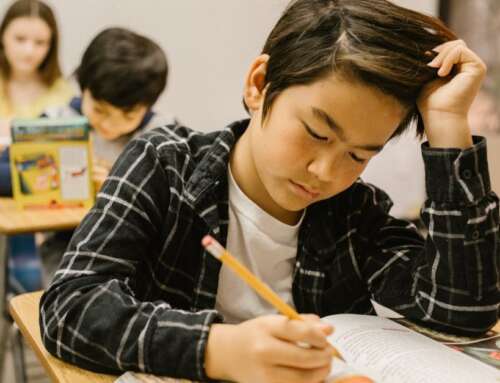If you’re schooling your children at home, chances are you’re very time poor. By teaching your children to cook, you could bundle up some learning while also getting dinner or lunch prepared.
Teaching children to cook healthy food helps them gain knowledge and skills across a range of subjects simultaneously. The bonus is, you could get a healthy meal prepared as well.
By focusing on nutritious recipes you’ll also address personal development, health and physical education topics.
Why cooking?
Being able to apply maths and science concepts to everyday situations helps develop self-confidence in daily activities.
Learning to follow a recipe and prepare food spans a number of core subjects such as English, through reading and comprehension. Being able to weigh and measure out ingredients draws on maths concepts of volume and measurement, and the skills of inquiry and problem solving are central to science.
Teaching children to cook, and focusing on preparing healthy foods, integrates knowledge from all these subjects and maximises learning opportunities by helping your children develop motivation and communication skills.
A study in 18 year four classes integrated maths and science into classroom teaching, using hands-on food based nutrition activities. The children in these classes improved their nutrition knowledge, while their knowledge in science and mathematics also improved significantly, compared to children in the 16 control classes who didn’t receive the integrated lessons.
A review of classroom healthy eating interventions found active learning activities such as cooking, food preparation and school gardening had the biggest impact on improving nutrition knowledge and dietary patterns.
This was especially the case when it came to getting children to eat more fruit and vegetables and reducing their intake of sugar and total daily kilojoules.
In Australia neither children nor their parents eat enough vegetables. Energy-dense, nutrient-poor foods (junk) account for one third of total daily energy intakes, and 41% for children and teenagers.
The Australian Guide to Healthy Eating recommends we keep junk food intakes low, while aiming for five serves of vegetables and two serves of fruit daily to stay healthy and prevent chronic diseases like type two diabetes and heart disease.
Only one in 20 adults and one in 17 children under 18 years of age meet these daily recommendations for both vegetables and fruit.
Involving children and teenagers in food preparation helps promote healthy eating habits, including eating more vegetables and fruit. An experimental study with 47 children aged 6-10 found when children cooked with their parents, they ate 26% more chicken and 76% more salad and felt happier compared to when the parent cooked alone.
Even watching healthy cooking TV shows can make a difference. A recent study with more than 100 children aged 10-12 found that after watching healthy food being prepared in a TV video, children were twice as likely to choose to eat healthily.
You can make cooking more challenging
It is common for children to think they don’t like maths and metrics, with achievement and engagement in maths declining globally. So it is important to find new ways to interest children in these areas.
Cooking is a real-life way to make abstract concepts relevant to your child. Show them how to compare, measure and order foods from smallest to biggest using metric units such as mass (weight), length, area and volume.
Basic maths skills are essential to accurately estimate food portion sizes, follow recipes and understand food labels.
This clear link between cooking, nutrition and maths highlights the potential to enhance learning in both subject areas.
To challenge your children’s maths ability even further, try limiting the cooking utensils used so more calculation is needed. For example, when a recipe calls for one cup (250mL) of rice, use the ¼ cup (62.5mL) measure and ask your children to work out how many of these they need to add.
Or use different types of kitchen utensils such as a measuring jug rather than a measuring cup to work out the gradations and pour the content of the cup into the jug and vice versa.
Cooking also provides the opportunity to discuss important nutrition topics with your child. Children find it easier to work out which foods are healthy and harder to identify which are unhealthy and why.
Try sorting a recipe’s ingredients into their basic food groups before you start cooking. Or try to estimate the number of serves per food group you have added when following a recipe.
Food art – if it looks good it tastes good
Arranging healthy foods in fun and creative ways helps kids like these foods more. An international study with 433 children from 14 countries showed beautiful food designs created using spinach and fruit increased children’s desire to eat these foods.
Using food art to improve enjoyment of healthy eating is a promising way to help picky eaters eat healthy foods.
Lots of resources are available to help make healthy cooking fun, fast and inexpensive.
Our healthy fast food cooking challenge is a collection of videos that show how well-liked classics such as burgers and pizza can be prepared in healthy ways, just as fast and at lower cost.
For some extra activities on food and measurement for primary school children, and a chance to explore imperial measurement, explore the USA FOODMASTER project.
Clare Collins, Professor in Nutrition and Dietetics, University of Newcastle; Berit Follong, PhD candidate, nutrition and mathematics education, University of Newcastle, and Tamara Bucher, Senior Researcher, University of Newcastle
This article is republished from The Conversation under a Creative Commons license. Read the original article.
Feature image source: Pxfuel
![]()







Leave A Comment